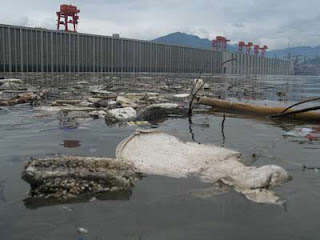Development of hydropower issues
a. Economics
The major advantage of hydropower is elimination of the fuel cost, immune to fossil fuels, such as oil, natural gas and coal with low construction and operating labor cost . The dam serves as multiple purposes.
b. Greenhouse gas emissions
Hydropower station does not burn fossil fuels, they do not directly produce carbon dioxide (a greenhouse gas). While some carbon dioxide is produced during manufacture and construction of the project, this is a tiny fraction of the operating emissions of equivalent fossil-fuel electricity generation.
c. Related activities
Reservoirs often provide facilities for water spots, and become tourist scenery.. In some countries, using dam for irrigation can support the fish farm and water supply. Large hydropower station can control floods, and be used for transportation.
2- Disadvantage
a. Damage to the environment
 |
| pollutants at upstream of Three Gorges Dam |
Hydropower projects can damage surrounding or downstream ecosystems of the plants. In some cases, dams have been demolished due to the impact on fish. It can lead to scouring of river beds and loss of riverbanks. In addition, it also has impact on birds. Since building dam for agricultural and energy use, many native and migratory birds have become increasingly endangered.
b. Population relocation
Hydropower station has the need to relocate the native people, whose history and culture sites may be flooded and lost. Such problems have arisen in the Three Gorges project.
3-Comparison with other methods of power generation
Compared to nuclear power, hydropower generates no nuclear waste and leaks. Unlike uranium, hydropower is a renewable energy resource. Compared to wind power, hydropower plants are predictable, which can be easily regulated in power demand. Compared to fossil-fueled power plants, hydropower stations take a long time to build. Unlike combustion turbines for fossil-fueled, which can be economically developed, hydropower production is limited; due to climate change Long-term energy production may be affected. Hydropower may incur additional cost to ensure availability of sufficient power in years lacking of water.










































